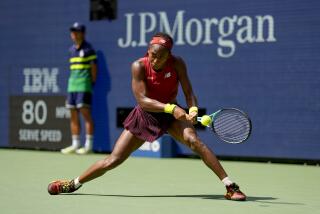For Her, Fairy Tales Came True
- Share via
INDIAN WELLS, Calif. — She’s sports’ Rhine maiden. Lorelei with a tennis racket. The girl from a fairy tale. You look at Steffi Graf and it’s easy to picture her on a rock in the Rhine, combing her golden hair and luring sailors to their destruction. A creature out of Germanic mythology.
This siren has shipwrecked the game of women’s tennis. She won its Grand Slam--Australian, French and U.S. opens and Wimbledon--in 1988.
Martina Navratilova never did that. Neither did Chris Evert or Billie Jean King. Margaret Court did it once, in 1970. Only Graf has done it since.
Navratilova won Wimbledon nine times. Graf has won it six times and holding. In 1993, she won the French and U.S. opens and Wimbledon, and was a finalist in Australia. Last year, she won the French, U.S. and Wimbledon--and didn’t play the Australian.
A case could be made that Fraulein Graf is the greatest tennis player of her sex--maybe any sex--ever. This takes in a lot of backcourts when you consider the sport had Helen Wills Moody, Suzanne Lenglen, Molla Mallory, Maria Bueno, Little Mo Connolly, Court and the assorted Evonne or Monica.
Women tennis stars have come historically from warm-weather venues or American and English aristocracies, who had the tennis courts right next to the polo field or as part of the mansion lawn. Pater put one in so the children could have something to do when the family yacht was laid up. It was as much the sport of kings as horse racing. If you weren’t royalty, at least you had a whole bunch of Roman numerals after your name. Or hyphens.
And, if you wanted a top-seeded player, you would try Coral Gables or Boca Raton--not Bruhl, Germany.
Until Graf and Boris Becker, Germany had never been a hotbed of tennis except for the brief, star-crossed career of Gottfried Von Cramm. And when I tell you Von Cramm was a baron, no less, you have all you need to know right there. Von Cramm was runner-up in three consecutive Wimbledon tournaments before disappearing in one of Hitler’s concentration camps.
Tennis has undergone a democratization of a sort since the days of barons and earls. Still, except for a brief intrusion by the great French players, Rene La Coste and Henri Cochet and Lenglen, it remained the property of the Americans and the Australians and people who didn’t have to live their lives periodically sweeping out the bomb damage.
Steffi--with an assist from Martina, Monica and Hana--brought the game into Central Europe. Graf had a racquet in her hand as soon as they got the baby rattle out of it. Myth has it she took her first steps on a base line.
There was never much doubt where Steffi would spend her life. Graf off a court is like John Wayne off a horse, Olivier off a stage.
Dad was a tennis teacher, and it would be tempting to say Steffi was Trilby to his Svengali, except Steffi liked tennis. She liked smashing the ball back at the startled feet of smug older opponents.
She didn’t look like a world-class tennis player. A world-class showgirl, perhaps. Those legs and all that blond hair. Marlene Dietrich with a forehand.
But at the tender age of 14, she was bringing her game to the Los Angeles Olympics. Tennis was a “demonstration” sport for the Games that year but Graf, the youngest competitor, won the tournament and what would have been the gold medal.
About a year and a half later, at the Berlin Open, she shocked the tennis world by beating Navratilova. She remembered the score at an interview here the other day, “6-3, 6-2.”
That was Rocky Balboa stuff. The world couldn’t have been more shocked if a yearling had won the Kentucky Derby. Navratilova won something like 89 matches that year and that was only the third she would lose.
Steffi Graf is not emotionless on court, but neither does she burst into tears, throw her racket or stalk off. Her concentration is legendary. Her father gets jailed for income tax evasion, her No. 1 competitor gets stabbed in the back at a German tournament--Graf plays through with gritted teeth and private horror. Tennis was her escape. She has had bone spurs pressing on the nerve in both heels? Her whole life is at set point? She’ll limp later. Right now, she’s shooting to hear “Advantage, Graf!”
It’s what she usually hears. She is gracing the field at the State Farm Evert Cup here this week at the Hyatt Grand Champions courts, where she is as big a draw as any of the four other Wimbledon champions in the seedings.
She lost two whole matches last year. Once, in 1989, she won 86 of 88 matches, 66 in a row. She can play on any kind of surface--”Steffi could win on an ice floe,” an English writer once grumbled. She has won the French on Roland Garros clay, four times; the All-England on Wimbledon’s grass, six times, the Australian and U.S. hard courts four times each.
She is a workaholic. Is burnout--a term more or less coined by tennis--a concern? Graf smiles.
“At times, you think about it,” she says. “You play--what is it?--12, 13 years? You see the same faces, you go to the same places. But I like to be around it. I just go out and play harder. I like to work hard.”
Graf is more than a tennis star. She’s the pro from the pages of Grimm’s fairy tales.
Growing up, she says, she never heard of Helen Wills Moody, or Little Mo, or Alice Marble. But that’s all right. Before she’s through, she might make everybody forget them.
*
* CHAMPIONS CUP
Ukraine’s Andrei Medvedev, 21, has the talent to become No. 1, but despite his success he remains troubled by the aftereffects of the Chernobyl disaster. C4
* EVERT CUP
In her first match back from injury after four months, Steffi Graf took 36 minutes to beat Kristina Triska,
6-0, 6-1. Jennifer Capriati defeated Rita Grande of Italy, 6-4, 6-1. C5
More to Read
Go beyond the scoreboard
Get the latest on L.A.'s teams in the daily Sports Report newsletter.
You may occasionally receive promotional content from the Los Angeles Times.










